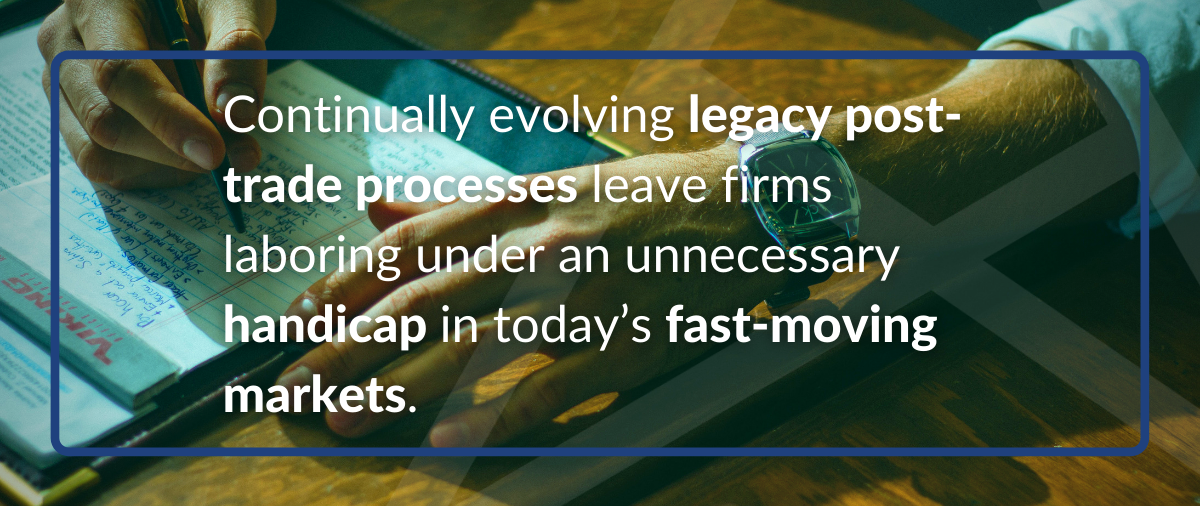The financial markets exist in a state of continual flux, and in recent years there has been a significant transformation in terms of complexity and trading volume. The rise in algorithmic and high-frequency trading has contributed significantly to the market’s evolution. More recently, the COVID 19 pandemic amplified volume and volatility, and it is abundantly clear that technology plays a pivotal role in keeping the market functioning not only during crises but every day. In a highly volatile, high volume, and complex market, firms that rely on human intervention are vulnerable to failures. All too often, post-trade processing remains reliant on a patchwork of legacy systems based on manual or technologically outdated processes.
Outdated technology and system failures cost firms money
For many firms, legacy post-trade processing systems entail high fixed costs and ongoing investment. One of the biggest fixed costs is salaries associated with the IT personnel necessary to manage the technology and cobble together solutions to keep patchwork systems running. Many of these legacy systems simply can’t handle today’s quantity of data and scale of operations. Stricter regulatory standards also impose great burdens on functionality. When systems can’t keep up, trades fail, and operational resilience deteriorates.
Some firms still use Excel to manage derivatives trades
Post-trade processing can become even more complex for assets like derivatives and commodities, which lack standardized referentials and can be accompanied by complex collateral and margin requirements. When data is not standardized and held in multiple systems, the need for constant reconciliation increases costs and the potential for error. Many firms are still using legacy systems incorporating Excel spreadsheets that must be manually updated. In today’s fast-moving markets, this is a disaster waiting to happen.
When firms gather data from disparate sources and process this data manually, they also lose a valuable opportunity to monetize the data with value-added analytics. Automated post-trade processing systems that leverage artificial intelligence and machine learning to data can handle multiple data sources and non-uniform referentials while employing analytical processes that help firms increase profitability and efficiency.
Legacy systems can weigh on your P&L.
Markets move fast and trades are made at lightning speed. Even the best traders make mistakes, and small mistakes can spawn big liabilities, particularly when firms engage in high frequency, computer-based trading. One mistake can lead to a significant hit to P&L.
Don’t develop a reputation for trade settlement issues
Clients tend to harbor strong feelings about trade processing and settlement failures. Mistakes are unacceptable and multiple errors may send clients looking for a broker with more reliable processing. Buy-side traders talk, and woe betides the brokerage firm that develops a reputation for problems settling trades.
Since 2008 regulatory requirements have tightened around the globe, and there has been a significant impact on post-trade processing activities like clearing and reporting. Firms that lack robust systems to collect, manage, store, and exchange transaction data can find themselves running afoul of regulators and facing stiff fines. Fines can be financially destructive and regulatory actions can be severely damaging to a firm’s reputation.
Don’t let antiquated systems show up in due diligence
Trade affirmation and reconciliation have been an important consideration in operational due diligence for over twenty years. But today, post-trade processing has assumed a significantly greater import in the due diligence process and is considered a critical component in any due diligence study.
In the past, auditors, investors, and regulators typically gave reconciliation short shrift, asking whether a reconciliation process existed and, if so, requesting that the policy be stated. But today’s due diligence questionnaires demand a detailed outline of the process, including a description of the specific activities undertaken, information about the manager who runs the process, and how it is integrated with the other elements requested in the ODD process. A rickety system that your IT department has patched together over the years is unlikely to impress potential clients.
SaaS solutions can offer a cost-effective alternative
Technological developments and the advent of the cloud mean that firms no longer have to rely on expensive in-house systems for post-trade processing. Today firms can leverage software-as-a-service solutions, like Theorem, that reduce costs significantly while enhancing the speed and quality of processing and adding powerful analytics capabilities.
Advanced technology that powers automation demonstrates its value in challenging market conditions, reducing the number of trade exceptions and allowing firms to focus on their primary business. Firms that rely on continually evolving their legacy post-trade processes are laboring under an unnecessary handicap in today’s fast-moving markets.
___
About the Author
Rebecca Baldridge, CFA, is an investment professional and financial writer with more than 20 years of experience in creating content and research for asset managers, investment banks, brokers and other financial services clients. She’s worked for some of the biggest names in the industry, including Merrill Lynch Asset Management, JP Morgan Asset Management, BNY Mellon and Franklin Templeton. Rebecca also spent 9 years as an analyst and director of equity research in Moscow, working for several Russian banks. In late 2019, she founded Quartet Communications, a boutique communications firm serving financial services clients. Her writing has been published in outlets including Pensions & Investments, MSNBC.com, Inc. magazine, and Investopedia.com. She holds a B.A. in Russian from Purdue University and an M.S. in Finance from the Krannert Graduate School of Management at Purdue.
